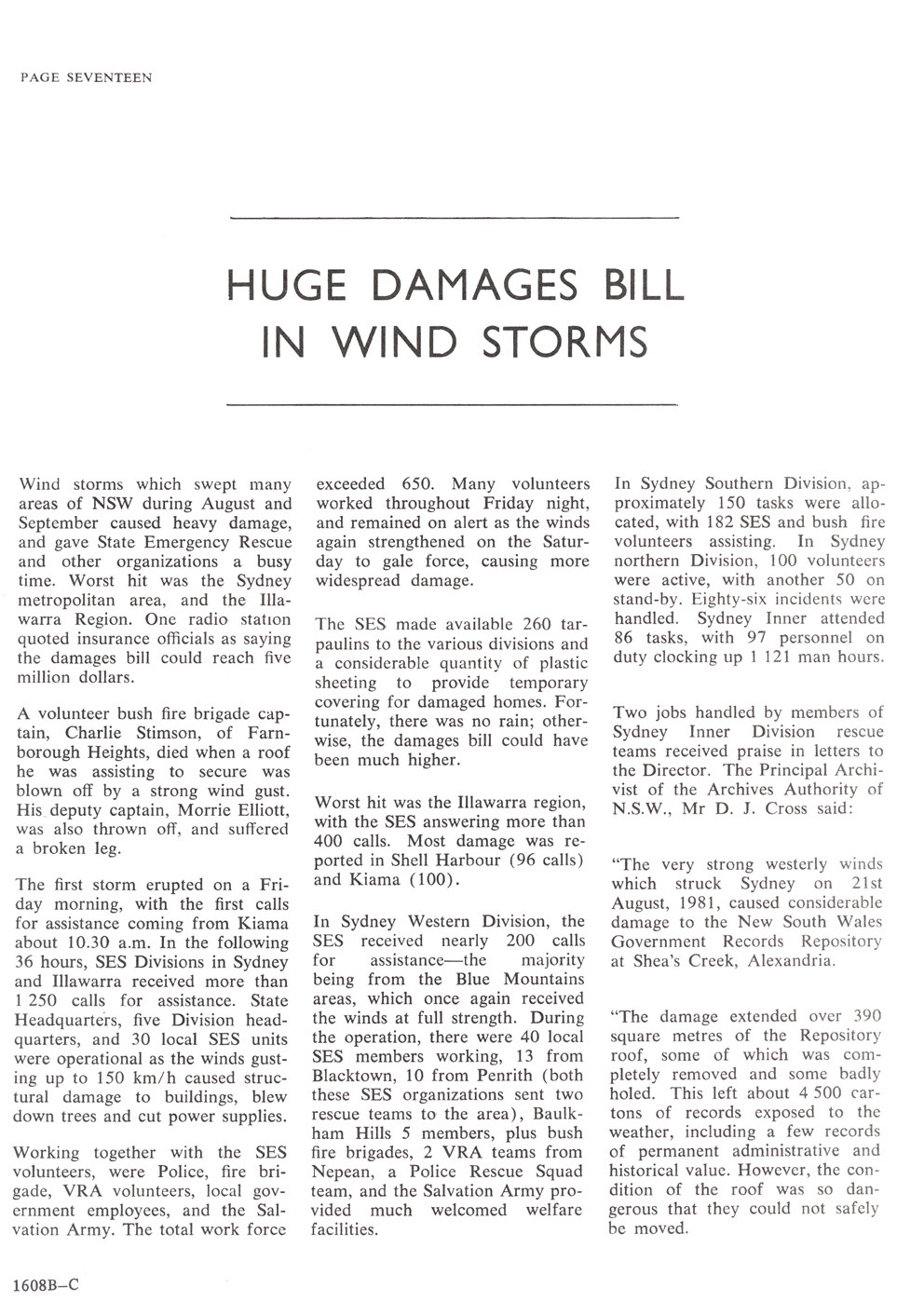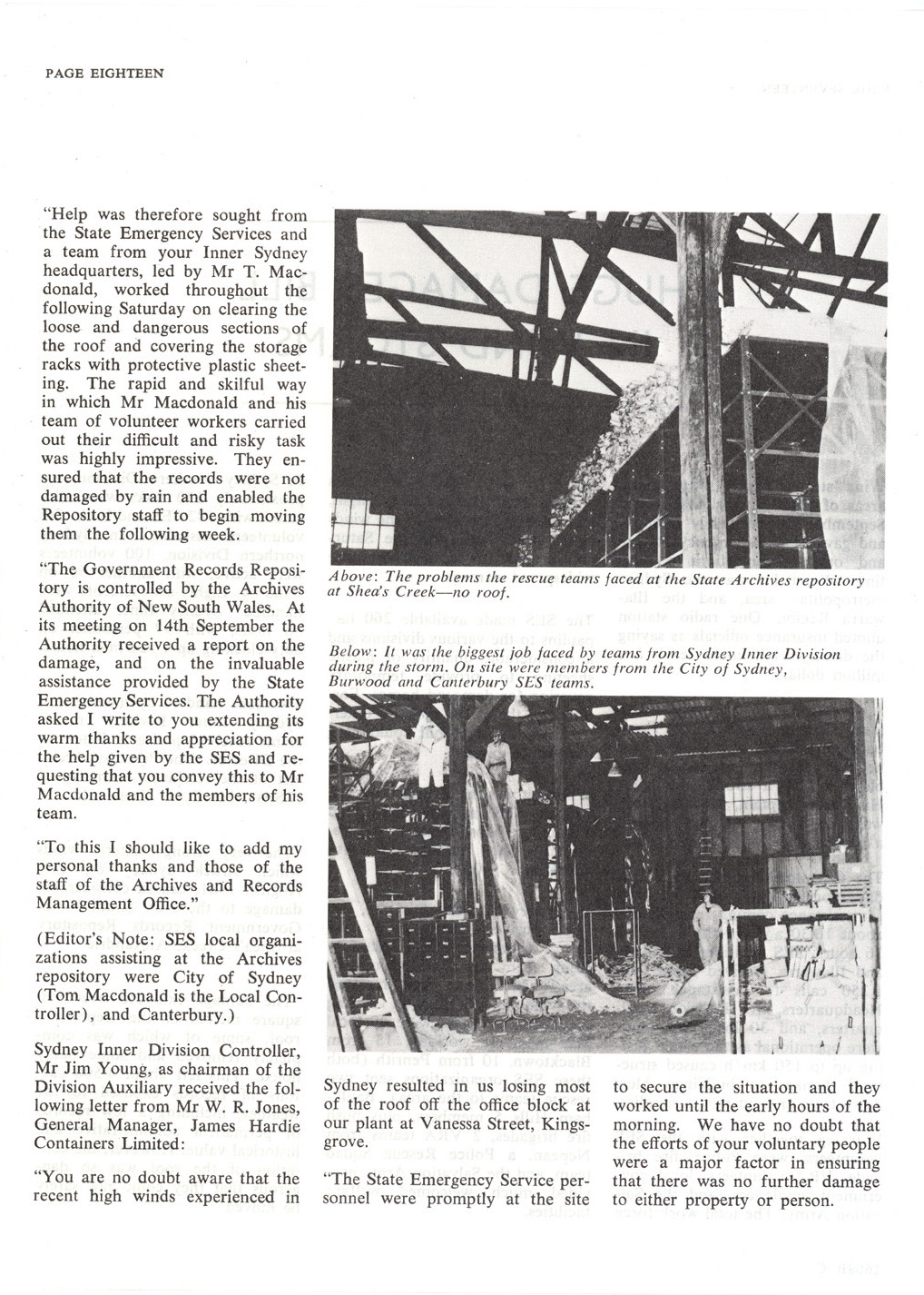Jenni Stapleton is the Manager of the Government Records Repository. This is her Staff Pick.
…
My favourite Archives are probably the ones that saved my life – quite literally!
It was back in the 80s
On 21 August 1981 a mini-tornado tore through Sydney while a number of GRR staff were working in the old Shea’s Creek repository, near the airport. The wind hit the building from the rear, picked up the fibre-cement roof and rolled it up like a carpet, spearing the broken pieces of roof down onto us as we ran for cover.
Building collapse prevented by archives
The whole building shook with the force of the gale. The noise was like standing near a jet engine. Afterwards the State Emergency Services personnel told us the only reason the building didn’t collapse was the massive weight of volumes stacked two metres high against the back wall. But for those books the wall would have come down with the roof and started a domino effect as the shelving fell.
Those tomes were hundreds of the heaviest, ugliest, dirtiest books I’ve ever seen. They came from the NSW Treasury and covered the State’s financial history from the 1880s to the 1940s. The story was that some departments of Treasury used a single ledger each year and these were deliberately made too large to be moved. The staff came to the ledger – not the other way round, which meant the records could never be lost. Most were full of incomprehensible financial data of little human interest as far as I could see. But not all. I remember one small series related to the handouts made for unemployment relief in the 1930s. I was astounded at the large number of vouchers for food that were distributed around the state. I’m sure there were many real human stories behind those numbers.
It just goes to show that while every Archive is originally made for a sound administrative purpose, you can never predict what added value it might acquire in time. Let alone that it might save your life.
Below is an article about the wind storm from SITREP – Official journal of the State Emergency Services of New South Wales [Summer 1982 edition, pages 17-19].






Marg Morters says:
Your ‘Archives Outside’ about the storm damage suffered when State Records were at Shea’s Creek got a ‘Well I never knew that’ from me
Odd times I have vaguely wondered where all the records were kept and by whom but it didn’t progress from that odd thought.
The Mitchell Library is only 100 years old .
I’ve only had the gene bug for 20 years . Perhaps you could consider an Archives Inside on just how State Records evolved to its status today ??
Who actually decided for example, that the Col Secs Correspondence papers should be saved and Bounty Index passenger records and where were these records stored say in the 1830/40s ? and who were the caretakers ? Bea Scanned wasn’t around back then !
Jenni Stapleton says:
Hi Marg,
Lovely to hear from you.
As my story illustrates, many records from the past have survived as much by good luck as by good management – and the same could be said of the staff in some cases!
NSW has never had war or natural disasters on the scale seen in other places which have had terrible impact on the survival of archives (and other historical collections) but still we have lost a lot of valuable material over the years. In particular there was the Garden Palace fire of 1882 in which large quantities of convict and early colonial records were destroyed.
Your mention of the Mitchell Library is very relevant because it was only through the actions of the Public Library of NSW deliberately trying to collect the existing historic records of the State that many of the early 20th Century archives lasted long enough to be preserved.
Next year is the 50th anniversary of the passing of the first Archives legislation in NSW and the establishment of the State Archives and a small historical publication is being planned to mark the event.
I’m glad you enjoyed my story.
Cheers
jenni
Louise Trott says:
Looking at the pictures of Shea’s Creek wool shed repository brought back many memories for me from 1986, when I (and several other students from the UNSW Archives Administration Diploma course) worked one day per week on the Department of Corrective Services records stored there. We were preparing the records to be lodged with State Records, a massive undertaking. The biggest hazards we faced then were pigeon droppings, dust, extreme heat, the knowledge that the lanolin which impregnated the wood made the place a tinderbox, and the terrible smell of bleach emanating from the adjacent Alsco Linen laundry. Ah happy days!
In 1987 some of us went on a tour of selected NSW prisons, in Sydney and country NSW, to collect more Dept Corrective Services records, which is an unusual way to spend one’s time, to say the least!
Jenni Stapleton says:
Hale Louise – fellow survivor of Shea’s Creek!
On the day State Records’ Shea’s Creek repository was finally closed a member of staff climbed up on the roof to souvenir the sign – which still sits proudly outside my office. He peered into the water tank on the roof, which had been the source of our drinking and ablutions water, and discovered the tank was half-filled with dead pigeons and all manner of other disgusting things.
Can you imagine the Risk Assessments today?